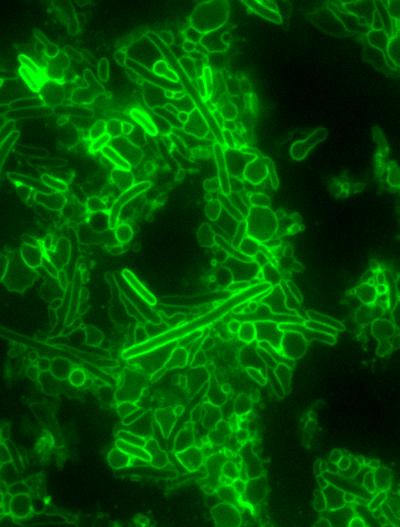
'Poisoned arrowhead' used by warring bacteria could lead to new antibiotics

These are bacteria devastated by attack with the toxic arrowhead.
Credit: T.E. Wood et al. (2019)
Researchers have uncovered a novel weapon in the arsenal of bacteria that works in a similar way to common antibiotics.
By discovering the mechanism of this new weapon, the team say new antibiotics could be designed to fill the gap left by rising levels of antibiotic resistance.
Lead author Professor Alain Filloux, from the MRC Centre for Molecular Bacteriology and Infection in the Department of Life Sciences at Imperial, said: “Bacteria evolved alongside each other for billions of years and have designed many strategies to fight and kill each other to prevail in the environment.
“This new 'toxic arrowhead' is one of the tools developed for this, and finding all the other possible strategies employed for bacterial warfare would help researchers and the pharmaceutical industry replenish the currently dwindling pipeline of antibiotics.”
The new study, published today in Cell Reports, looked at the Type VI Secretion System (T6SS) – a 'molecular crossbow' that some bacteria use to launch toxic packages at rival bacteria. Bacteria fight for dominance to control food sources and space, allowing them to thrive in their environment.
The team discovered a new kind of toxic arrowhead used by the bacterium Pseudomonas aeruginosa, called VgrG2b, with the toxin found at the very tip. By analysing the atomic structure of the toxin, the team showed that it is an enzyme known as a metallopeptidase, which cuts up proteins.
Once fired into a rival bacterium, VgrG2b targets the cell envelope, between the inner and outer bacterial membranes and encompassing the cell wall. Dr Abderrahman Hachani, now at the University of Melbourne, said: “This vital area provides structural integrity to the cell, regulates its growth, and acts as a protective barrier against the external environment.”
VgrG2b prevents the cell from dividing, causing it instead to bulge and eventually explode as the integrity of the cell fails.
This form of attack is similar to how a group of antibiotics, called beta-lactams, work. These antibiotics include penicillin, and as is the case with many classes of antibiotics, many harmful bacteria are becoming increasingly resistant to them.
Dr Thomas Wood, now at Harvard Medical School, said: “The impact of VgrG2b on target cells mimics the action of beta-lactam antibiotics. Yet it is clear that its mode of action is different. By further understanding and characterising the molecular targets of VgrG2b, and how the toxin works, this research would support the design of new antibiotics.”
###
The research was supported by the Medical Research Council and the Wellcome Trust.















